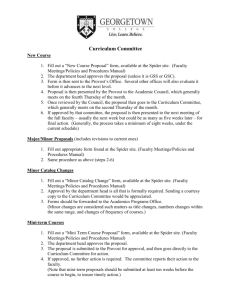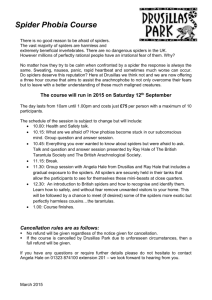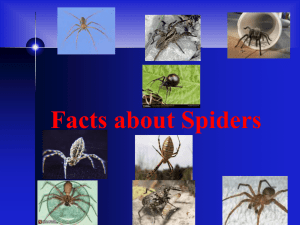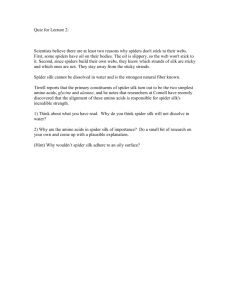How to Identify (and misidentify) the hobo spider
advertisement
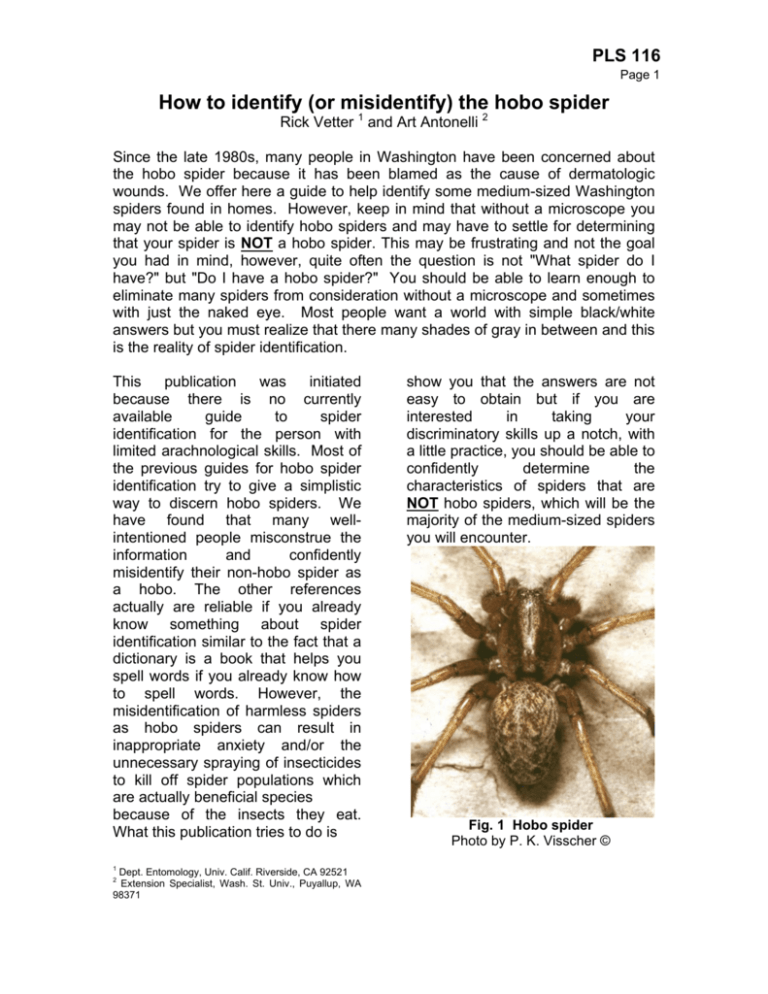
PLS 116 Page 1 How to identify (or misidentify) the hobo spider Rick Vetter 1 and Art Antonelli 2 Since the late 1980s, many people in Washington have been concerned about the hobo spider because it has been blamed as the cause of dermatologic wounds. We offer here a guide to help identify some medium-sized Washington spiders found in homes. However, keep in mind that without a microscope you may not be able to identify hobo spiders and may have to settle for determining that your spider is NOT a hobo spider. This may be frustrating and not the goal you had in mind, however, quite often the question is not "What spider do I have?" but "Do I have a hobo spider?" You should be able to learn enough to eliminate many spiders from consideration without a microscope and sometimes with just the naked eye. Most people want a world with simple black/white answers but you must realize that there many shades of gray in between and this is the reality of spider identification. This publication was initiated because there is no currently available guide to spider identification for the person with limited arachnological skills. Most of the previous guides for hobo spider identification try to give a simplistic way to discern hobo spiders. We have found that many wellintentioned people misconstrue the information and confidently misidentify their non-hobo spider as a hobo. The other references actually are reliable if you already know something about spider identification similar to the fact that a dictionary is a book that helps you spell words if you already know how to spell words. However, the misidentification of harmless spiders as hobo spiders can result in inappropriate anxiety and/or the unnecessary spraying of insecticides to kill off spider populations which are actually beneficial species because of the insects they eat. What this publication tries to do is 1 Dept. Entomology, Univ. Calif. Riverside, CA 92521 Extension Specialist, Wash. St. Univ., Puyallup, WA 98371 2 show you that the answers are not easy to obtain but if you are interested in taking your discriminatory skills up a notch, with a little practice, you should be able to confidently determine the characteristics of spiders that are NOT hobo spiders, which will be the majority of the medium-sized spiders you will encounter. Fig. 1 Hobo spider Photo by P. K. Visscher © PLS 116 Page 2 A general warning Most non-arachnologists try to use coloration as a diagnostic identifying feature. This is one of the least reliable characteristics for identification of hobo spiders because of the great variation amongst specimens within a species and because similar species sometimes overlap in their appearance with hobos. If you try to identify them by size, you will also be mistaken because the variation is tremendous. Many other species look the same to the non-arachnologist who lumps them all together as hobo spiders and often is wrong. If you continue to try to determine spiders with coloration or size, then this publication is not going to help you. You must be willing to take your skills above the level of the nonarachnologist, learn a few anatomical structures and then you will have better success. As an analogy from the world of ornithology, it is easy to determine an eagle from an owl, etc. but it takes much more skill and effort to differentiate amongst the many species of similar-looking warblers. Thus, it is the same for the hobo spider and many of the medium-sized Washington spiders. You will need to be more discriminating when dealing with hobo spiders because identification is not easy. This guide is geared toward the interested reader who has a magnifying lens or hand lens, similar to what Master Gardeners or entomologists would use. Yet even with a lens, quite often you may be able to determine that your spider is NOT a hobo spider and nothing more. For the few who have access to microscopes we present information on how to definitively identify hobo spiders to species. For the advanced beginner, this can only be reliably achieved by comparing the male and female reproductive structures to the pictures presented here. If you are able to do this, you can learn the skills of an amateur arachnologist and can determine without a doubt whether or not you are in possession of a hobo spider. We present mostly identification information here. If you wish to learn the biology or other aspects, you should check out the references at the end of the article. A little bit about the spiders The hobo spider is found throughout Washington and makes a funnel web which is a trampoline-like flat sheet leading back into a hole between bricks, under wood or in shrubs. However, there are many closely related species of spiders which also make similar webs so just because you see funnel webs on your property, does not mean that there are hobo spiders in those webs. The scientific name of the hobo spider is Tegenaria agrestis. Also living in Washington are 2 other closely related spiders, the giant house spider, Tegenaria duellica (known as Tegenaria gigantea to some) and the barn funnel weaving spider, Tegenaria domestica (also known as the domestic house spider to some). All three of these spiders originated in Europe. Related spiders (Agelenopsis potteri, Agelenopsis pennsylvanica and Hololena nedra ) are often misidentified as hobo spiders. All of these are common Washington spiders which are brown, make funnel webs and belong to the family Agelenidae. PLS 116 Page 3 Anatomy You will need to know some important diagnostic anatomical features (Figs. 2, 3) in order to be more discriminating with spider identification. Cephalothorax - the first main body part to which the legs are attached Abdomen body part - the second main Palp - the male reproductive structure. This is a swelling or knob on the end of the "feelers" in front of the body. Some people have described it as looking like a pair of boxing gloves. Fig. 2 male black widow spider Photo by D. Boe © Sternum - on the underside of the cephalothorax. A flat, shieldlike surface surrounded by the legs Epigynum the female reproductive structure, a hardened, darkened structure on the underside of the abdomen closer to the cephalothorax than the middle of the abdomen. Immatures and male spiders have nothing in this area. Fig. 3 left - giant house spider right - hobo spider Photo by R. Vetter © If you have a hand lens…. - what is NOT a hobo spider If the only magnifying device you have is a hand lens, you may have to be satisfied with knowing what is not a hobo spider. Try this out and very soon, you will be able to hone your skills and possibly move up to the next level of identification such that hobo spiders will be very easy to identify. PLS 116 Page 4 1- Spots on the sternum? Not a hobo If your spider has 3 or 4 pairs of light spots on the lateral portions of the sternum (Fig. 4), THEN IT IS NOT A HOBO SPIDER. These spiders are the other two Tegenaria species, the giant house and the barn funnel weaving spiders. Hobo spiders have a light stripe running down the middle of the sternum. So the rule here is, "If you see spots, then a hobo it's not". However, be aware that in some specimens of the Fig. 4 left - giant house spider giant house and barn funnel right - hobo spider weaving spiders, the spots are Photo by R. Vetter very, very faint and hence look very similar to a hobo spider This is why we emphasize that you can't use coloration alone to accurately identify a hobo spider. The giant house spider is more common than the hobo spider in the Pacific area west of the Cascade Mountains. These spiders are usually much larger than hobo spiders (and people assume bigger spiders are more dangerous). In western Washington cities, they typically outnumber hobo spiders about 3 to 1 so therefore, you are much more likely to encounter a giant house spider than a hobo spider. There are no populations of giant house spiders east of the Cascades in Washington so a spider with a spotted sternum is probably the smaller barn funnel weaving spider. 2- Distinct stripes on the cephalothorax? Not a hobo If your spider has two very distinct longitudinal dark stripes on the top side of the cephalothorax (Fig. 5), THEN IT IS NOT A HOBO SPIDER. Hobo spiders have indistinct or diffuse patterns. Washington spiders with distinct dark stripes are either Agelenopsis or Hololena spiders and possibly some wolf spiders. Unfortunately, these spiders do not have common names Fig. 5 Hololena species spider Photo by D. Boe © 3- Dark rings around the legs? Not a hobo If you can see dark rings around the legs of your spider (Fig. 5), THEN IT IS NOT A HOBO SPIDER. Hobo spiders have uniformly colored legs. The most PLS 116 Page 5 common spiders that have rings around their legs are the barn funnel weaving spider and some of the other agelenid spiders like Hololena. 4- Legs and cephalothorax are shiny and dark-orange in color? Not a hobo. If your spider has legs that are shiny and lacking fine hairs, THEN IT IS NOT A HOBO SPIDER. If the cephalothorax is also shiny and dark-orange to a mahogany in color, this is probably a Callobius spider (Fig. 6). There are many species of Callobius spiders in Washington however, Callobius severus is one of the most common and most widespread in Washington's most heavily populated areas. This spider is very often submitted as a potential hobo spider because of the pattern on the abdomen. Also in the side view, the palp of Callobius males has large, conspicuous, pointed projections (Fig. 7). Hobo spiders have one very small flat-top projection (see Fig. 9). The palp of the male Callobius spider is not the one from the Pacific Northwest but it will look similar enough to it such that you will be able to recognize it. Fig. 6 Callobius spider Photo by David Phillips © www.riverfriends.com Fig. 7 Male Callobius palp projections (top of palp is cut off in the picture) Photo by R. Vetter © 5- The palp of the male is long and pointy? Not a hobo. If the extreme fleshy tip of the male palp is long, thin and finger-like, THEN IT IS NOT A HOBO SPIDER. If you look at Figures 8 & 9, two of the three male palps of the closely-related Tegenaria species have long, pointed, finger-like tips. The tip of the hobo spider is more blunt. So how do you tell for sure that you have a hobo spider? Unfortunately, the answer is that unless you are able to examine the very small reproductive structures, you are cannot definitively identify a hobo spider. But if you have progressed this far in your arachnological skills, you will realize that you PLS 116 Page 6 have eliminated many spiders from consideration as hobo spiders which may be sufficient for your needs. The only sure way to identify a spider as a hobo spider is to compare its reproductive structures that define it as a species. You will probably need a microscope to examine these structures. HINTS FOR OBSERVING SPIDERS UNDER A MICROSCOPE 1- FORCEPS: You should have two pairs of forceps for manipulating spiders, moving legs out of the way, etc. The finer the tips the better. BioQuip in southern California has everything entomological. They have inexpensive fine forceps for about $2.50 but if you wish to get the professional models, watchmaker's forceps are the best. They cost about $15 a pair and are also available from BioQuip and probably from various other sources like electronics stores, medical supply places, etc. 2- ILLUMINATION - you should have a strong illumination source, preferably from the side that will give better contrast of the features. Straight-on lighting will make the subject look flat. Example, photographs of hills and mountains show much more detail of the topography at dawn and dusk because they accentuate the differences in contours. The same goes for microscopic spider work. If you don't have a scientific illuminator, a high-intensity flashlight should be sufficient. If you are having trouble seeing some of the structures, move the illumination source around. This will give you different perspectives of the contours of the features. 3- SUBMERGE THE SPIDER IN ALCOHOL: to properly identify spiders, the spider needs to be completely submerged in alcohol. The reason for this is that the hairs of the body will cloak important features or distort the light. If the spider is completely submerged in alcohol, you will be looking at fewer reflections off the body parts. 4- ALCOHOL: If you are at a scientific institution, you should have no trouble getting ethanol which should be diluted to 70% with water. The general public can obtain denatured alcohol (purposely contaminated with compounds like acetone (i.e., nail polish remover) so that it is not potable). Rubbing alcohol (isopropyl alcohol) is 70% right off the drugstore shelf but causes specimens to become brittle and there are some health risks for humans more so than ethanol. 5- OBSERVING SPIDERS ALIVE: if you don't want to kill the spider, you can place the spider in a clear plastic bag and then gently flatten the bag against a contrasting surface. The spider will then be immobilized with its legs out flat and with practice, you should be able to see many of the features mentioned here. After that, you can just release the spider to the garden so it can eat more insects. PLS 116 Page 7 Male palps The best way to examine the male reproductive structures is to remove them from the spider because the legs often get in the way, the palp usually curls downward making it otherwise difficult to identify. Once you remove the palp, place it such that you can see all the surface structures. By convention, arachnologists always remove the left palp from a mature male spider. (Be aware that the palps of immature male spiders are merely swollen bulbs with no structures on it. They have one more molt to maturity. If this is what you have, species identification is virtually impossible and you might as well throw it away.) In this publication, we will only address the different palps of the three Tegenaria species because by the time you have gotten this far, you should have eliminated the other spiders as non-hobos. Actually by this time you should have been able to eliminate most of the normal-looking giant house and barn funnel weaving spiders too. Again, because of variation in color and size, several specimens have fooled experts until the reproductive structures were examined. Fig. 8 Left male palps showing differences in the surface features Left - hobo spider, center - giant house spider, right - barn funnel weaving spider Photo by R. Vetter © With the left male palp lying "on its back", you should see a variety of complex structures. Although this may appear difficult, as you look more closely, you will see darkened prominences arising from the palp. In the hobo spider, there is a hardened structure that wraps around on the outside of the palp, curves toward the middle and has two little prongs on the end. In the giant house spider, there is a thick prong, which points downward away from the palp. In the barn funnel PLS 116 Page 8 weaving spider, there is a short prong near the top which just pokes toward the outside. If you can identify the palp to any of the pictures here, then you have performed the task of a qualified arachnologist and have definitively identified the spider to species. Fig. 9 Side view of left male palps showing differences in the RTAs left - hobo spider, center - giant house spider, right - barn funnel weaving spider Photo by R. Vetter © In a side view, there is a structure on the tibia called the retrolateral tibial apophysis (RTA). In the hobo spider, the RTA (Fig. 9) is a single projection that is squared off on top. In the giant house spider, the RTA has two projections, each on the end of a saddle. In the barn funnel weaving spider, there is a single projection that is pointed on top. We realize that the structures on the male palp may be difficult to discern here despite slight digital-enhancement. However, after comparing these pictures to actual palps under a microscope, you should readily become more proficient at determine hobo spiders. These images should give you an idea of some characters such that you can eliminate some spiders from consideration. Also in the figure above, for the giant house spider you can see the longer fingerlike, upward extension and also the downward projecting prong on the surface of the palp. The size differences between spiders can also be detected. PLS 116 Page 9 Female Epigynum The epigynum of the female is the opening to her reproductive organs and is usually a hardened plate. It is located on the underside of the abdomen. This is going to be more difficult than the male and you will surely need a microscope for this whereas with the male palp, sometimes a very good hand lens will suffice. In immature females, there is nothing near the location where the epigynum will eventually form and you might as well throw away the specimen. In the hobo spider, the epigynum contains a large atrium (cavity), in the middle, which is surrounded by thick, raised ridges (in Fig. 10, two slanted white side ridges and one below). If you can see an epigynum similar to the figure to the right, then you have a hobo spider because nothing else looks like this. Be aware that other spider species have an atrium but it looks very different. Fig. 10 hobo spider epigynum Photo by R. Vetter © Female giant house spiders (Fig. 11) have no atrium (the middle portion is a shiny, flat surface) and have large pointed spurs near the bottom of the epigynum that point toward each other. You may need to remove the hairs from this area with a needle to see the spurs. Fig. 11 giant house spider epigynum Photo by R. Vetter © The barn funnel weaving spider (Fig. 12) is sometimes very difficult to identify because the variation in the epigynum sometimes leaves a very subtle structure. However, the barn funnel weaving spider female epigynum does not have an atrium and looks something like a bracket with a blurry spot on either end. Fig. 12 barn funnel weaving spider epigynum Photo by R. Vetter © PLS 116 Page 10 References providing biology and distribution information: Akre, R. D., and E. A. Myhre. 1991. Biology and medical importance of the aggressive house spider, Tegenaria agrestis, in the Pacific Northwest (Arachnida: Araneae: Agelenidae). Melanderia 47: 1-30. Baird, C. R., and R. D. Akre. 1993. Range extension of the aggressive house spider Tegenaria agrestis into southern Idaho, Utah and Montana. Proc. Wash. St. Entomol. Soc. 55: 996-1000. Crawford, R., and D. K. Vest. 1989. The hobo spider and other European house spiders. Burke Mus. Educ. Bull. #1, 4pp. Vetter, R. S. 2001. Hobo spider. Univ. Calif. Pest Notes #7488, 3 pp. (http://www.ipm.ucdavis.edu/PMG/PESTNOTES/pn7488.html) Vetter, R. S., A. H. Roe, R. G. Bennett, C. R. Baird, L. A. Royce, W. T. Lanier, A. L. Antonelli and P.E. Cushing. (submitted). Distribution of the medicallyimplicated hobo spider (Araneae: Agelenidae) and its harmless congener, Tegenaria duellica in the United States and Canada. (J. med. Entomol. - in press.)


